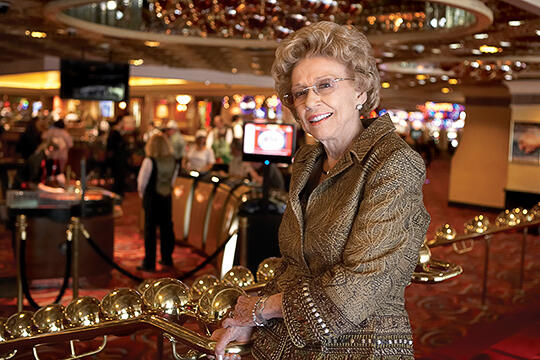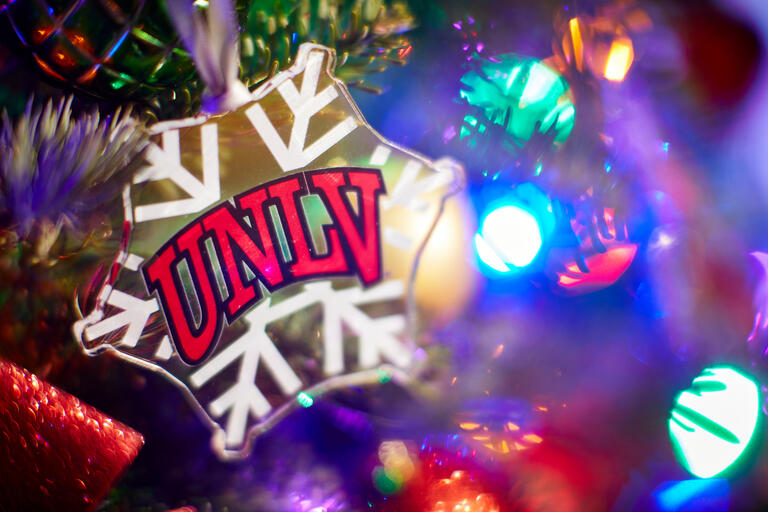This piece comes from David G. Schwartz, the Center for Gaming Research at UNLV, the largest repository of English-language books, journals, and primary materials for gaming research.
Women have been prominent in Nevada gaming since its inception. In fact, the first license issued under the modern regime of legal commercial gaming was granted to Mayme Stocker in 1931. Since then, women have had critical roles in shaping the state's gaming industry.
 1. Mayme Stocker
1. Mayme Stocker
Mayme Stocker, like many other Americans, came West with the railroad in the early 20th century. Stocker, her husband, Oscar, and her three sons, Lester, Clarence, and Harold settled in Las Vegas in 1911. Railroad companies--the employer at various times of her husband and sons--forbid workers from owning saloons or gambling clubs, so Mayme was the owner of the Northern Club, a card room that opened at 15 Fremont Street in 1920. Her son Harold, unemployed after a railroad strike, became the club's chief operator.
Shortly after Governor Fred Balzar signed the 1931 bill legalizing commercial gambling, Mayme Stocker, with partner Joe H. Morgan, applied for a license to turn the Northern Club into a bona-fide gambling hall. They received it, and the property, which is now La Bayou, has been open ever since, although Stocker sold her ownership interested a few years after its opening.
Stocker, who was a member of the Ladies Auxiliary to the Brotherhood of Railroad Trainsmen, the Daughters of the American Revolution, and other community groups, died in 1972, having seen gambling in Las Vegas spread far beyond anything she could have conceived in 1931.
2. Judy Bayley
Judy Bayley moved to Las Vegas with her husband, Warren, to open the Hacienda Hotel, which debuted in 1956 and which added a casino the following year. They already had a thriving chain of Haciendas in California, and the new hotel appealed to the mass market--a visionary move for the time, and one which other casinos would begin to adopt two decades later. Since the Hacienda, at the far southern end of the Strip couldn't rely on foot traffic, it started its own airline, which flew customers in from several cities.
After Warren's death in 1964, Judy took over operations, proving that a woman could run a major Las Vegas Strip resort. She was the first woman, in fact, to solely own a Nevada casino resort. She fought to add keno to the Hacienda's gaming offerings, the first Strip casino to do so, and she commissioned the famous "horse and rider" neon sign for the Hacienda. That sign now welcomes visitors to Downtown at Fremont and the Boulevard.
She was well known throughout Las Vegas for her philanthropic endeavors, which included the March of Dimes, the American Cancer Association, and the Nevada Heart Association. She was also integral in securing the funding for UNLV to build the Judy Bayley Theater.
3. Sarann Knight Preddy 
Sarann Knight Preddy broke a major barrier in 1950, when she became the first African American woman licensed to own a gambling establishment, Hawthorne's Tonga Club.
Preddy first moved to Las Vegas in 1942, but soon after moved onto California to attend business school. She returned to Las Vegas, settling on the city's Westside and working in the Cotton Club as a keno writer. She then learned how to deal blackjack, an essential step forward in her gaming career. In 1950, she moved to Hawthorne with her husband, William Scruggs. She bought the Lincoln Bar, applied for and received a gaming license, and operated it as the Tonga Club until her 1957 return to Las Vegas. She dealt blackjack in several Westside clubs until the passage of a city ordinance forbidding women from dealing. She then owned several businesses before returning to casino work at Jerry's Nugget.
Preddy became a principled fighter for both civil rights and the preservation of Las Vegas history, helping to found the Las Vegas Barbara Jordan Democratic Club and the Las Vegas Black Historical Society.
 4. Jeanne Hood
4. Jeanne Hood
Jeanne Hood's career is of interest because she came into the gaming field just as it was undergoing a major transformation, and her active role in it is indicative of the opportunities opening up for all Nevadans at the time. Hood (pictured on left with Audrey Tassinari) was part of Nevada's transition to corporately owned casinos. Her husband, Dave, became president of Hyatt Nevada in 1972. The company's chief operation was Downtown Las Vegas's Four Queens casino, which had been opened in 1966 by Ben Goffstein and bought by Hyatt in 1972.
After Dave's death in 1977, the Hyatt board selected Jeanne to run the company's Nevada operations. She was instrumental in enlarging the role of slot machines--particularly dollar slot machines--on the casino floor, which proved to be a bellwether for the industry as a whole.
She was involved with many local organizations, including the Fremont Street Experience, the local chapter of the American Diabetes Association, Nevada Dance Theater, and Opportunity Village.
5. Claudine Williams 
Claudine Williams, in her long career in gaming, took the industry from its illegal past to its current respectability. Born in Mansfield, La., she dropped out of high school at age 15 to begin working in the gambling business, which was not graced with much regard for legality at the time. At one time, she worked in Dallas for future Las Vegas icon Benny Binion. Owning her own gambling hall before the age of 21, she was a force to be reckoned with in the rough-and-tumble world of Texas gambling.
Williams moved to Las Vegas in 1964 with her husband, Shelby. Very much equal partners, they bought the Silver Slipper casino. After selling it to Howard Hughes in 1969, she and Shelby built the Holiday Casino, which has been hailed as one of the best-designed casinos of its era. After Shelby died in 1977, she became the president and general manager of the casino, a Nevada first for a woman.
In 1983, she sold her interest in the Holiday Casino to Holiday Inns, which had already acquired Bill Harrah's Northern Nevada casinos. Williams then became the chairwoman of the hotel, a title that she held for many years afterward. She distinguished herself with her outsize philanthropy, giving generously to many educational initiatives, including many UNLV programs.



